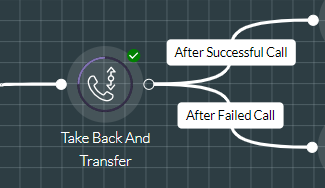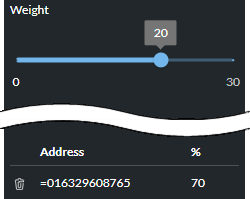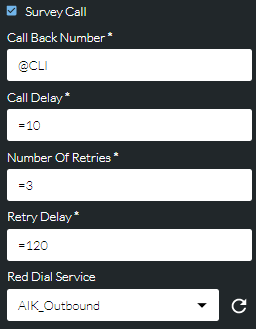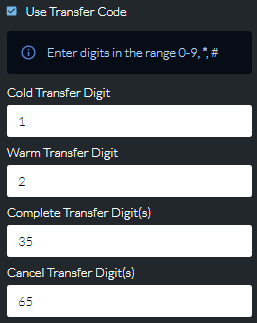Take Back and Transfer
|
Routes a call to an outbound destination number (B-party) with the capability of taking the call back and connecting the original caller (the A-party) to another destination (the C-party). |

Use this when calls to a contact centre are regularly transferred to another contact centre.
The action cell also allows you to add the caller to a callback list so the system can call the customer back to offer them a customer survey via an automated OUTBOUND service. If callers are given the option to stay on the line following a call in order to complete the survey, they can be removed from the callback list once they have completed the survey.
Properties
Take Back and Transfer Section
Take Back and Transfer Section
Use this section to define the initial call destination.
|
Option |
Description |
|
Number Selection Type |
Select 'Sequential', 'Random', or 'Weighted'. |
|
Outbound Address Type |
Select 'Number List' to build the list in the action cell. Or, select 'Delivery Point List' to use a pre-configured delivery point or delivery point group. Delivery points are configured in storm STUDIO as explained in the storm STUDIO User Guide. A delivery point may be capped at a maximum number of simultaneous calls, typically corresponding to the number of agents who can take calls at that location. When allocating calls to delivery points, the system will call the first delivery point until the maximum number of simultaneous calls for that number is reached, and then proceed to the next in the list. |
|
Address/ Delivery Point |
If you are routing the call to a number list, enter a number to route to (as a literal value) and then click ADD to add it to the list below.
Or, if routing to a delivery point list, select the preconfigured delivery point/group.
|
|
This is shown for the 'Weighted' number selection type. If you have a list of destination numbers to dial, use the slider to select a percentage weighting for the number or delivery point you are adding. A destination assigned a 50% weighting is twice as likely to be selected for dialling as one that is assigned a 25% weighting, for example. When a selected number is dialled but is not connected on the first attempt, it is not retried. Another number is selected according to the weightings applied to the undialled numbers in the list.
The scale maximum reflects the percentage weight remaining as you add destinations. |
Call Media Section
Use this section to configure the audio prompts to play to the calling party (A-party) as the initial call is routed.
|
Option |
Description |
|
Media Lists |
Use this to select the media list that contains the prompts that you want to play to the calling party. See also, Use Media in a Script. |
|
Use Hold Prompt/Hold Prompt |
Select this if the calling party should hear hold music or a hold message when they are put on hold and then choose the hold music or message to play. See also, Use Media in a Script. |
|
Use Fail Prompt/Fail Prompt |
Select this if the calling party should hear a failure message if the outbound call fails and then choose the message to play. See also, Use Media in a Script. |
|
Use Whisper Prompt/Whisper Prompt |
Select this to play an audio message to the called party immediately prior to connection and then choose the whisper message to play. See also, Use Media in a Script. |
Call Options Section
Use this section to define call-handling settings for the initial outbound call and also settings for survey calls.
|
Option |
Description |
|
Call Timeout |
Specify the period after which the service should deem the call routing attempt to have failed or the period after which it should attempt the next number in the list, if present. |
|
Forward A party's origination number |
Select this if you want the called party to see the calling party's origination number. |
|
Forward user defined origination number/ Origination number |
Select this if you want the called party to see a custom number and then specify the number in the Origination Number field. |
|
Record Call |
Select this to record calls. Call recording continues if the call is transferred. |
|
Survey Call |
Select this to include callers in a callback list for a survey and then complete the fields shown.
|
|
Call Back Number |
Applies to survey calls only Specify the callback number for the survey. This must be a value that is provided as a literal preceded by =, or a variable of the correct type. |
|
Call Delay |
Applies to survey calls only. Specify the number of seconds that should elapse between the call clearing and callback initiation. This must be a value that is provided as a literal preceded by =, or a variable of the correct type. |
|
Number Of Retries |
Applies to survey calls only Specify the number of retry attempts for the callback. This must be a value that is provided as a literal preceded by =, or a variable of the correct type. |
|
Retry Delay |
Applies to survey calls only Specify the number of seconds that should elapse between each retry attempt. This must be a value that is provided as a literal preceded by =, or a variable of the correct type. |
|
Red Dial Service |
Applies to survey calls only Select the name of the OUTBOUND script for initiating the callback, launching the automated survey script, and managing retry attempts. |
Transfer Media Section
Use this section to configure the audio prompts to play during a call transfer.
|
Option |
Description |
|
Transfer Media List |
Use this to select the media list that contains the prompts that you want to play to the calling party. See also, Use Media in a Script. |
|
Use Transfer Prompt/Transfer Prompt |
Select this if the calling party should hear a transfer message during the transfer and then choose the transfer message to play. See also, Use Media in a Script. |
|
Use Transfer Fail Prompt/Transfer Fail Prompt |
Select this if the calling party should hear a failure message if the transfer fails and then choose the message to play. See also, Use Media in a Script. |
Transfer Options Section
Use this section to define call-transfer settings.
|
Option |
Description |
|
Transfer Timeout |
Specify the period after which the service should deem the transfer attempt to have failed. |
|
Forward presented A party number |
Select this if you want the third party (C-party) to see the calling party's origination number. |
|
Forward user defined origination number/ Origination number |
Select this if you want the third party to see a custom number and then specify the number in the Origination Number field. |
|
Use Transfer Code |
Select this to allow the B-party to initiate a transfer using a transfer digit. Then, use the fields below to specify the transfer digits to use.
|
|
Cold Transfer Digit |
Specify the digit to initiate a cold transfer. A cold transfer is a direct transfer to the C-party without consultation. |
|
Warm Transfer Digit |
Specify the digit to initiate a warm transfer. A warm transfer is one where the B-party speaks to the C-party asking if they want to take the call. |
|
Complete Transfer Digit(s) |
Specify the digits to complete a warm transfer. |
|
Cancel Transfer Digit(s) |
Specify the digits to cancel a warm transfer. |
Exit Points
|
Exit Point |
Description |
|
After Successful Call |
This is taken after the call (including a transfer leg) has ended. |
|
After Failed Call |
This is taken if all attempts to route the initial outbound call failed. |




